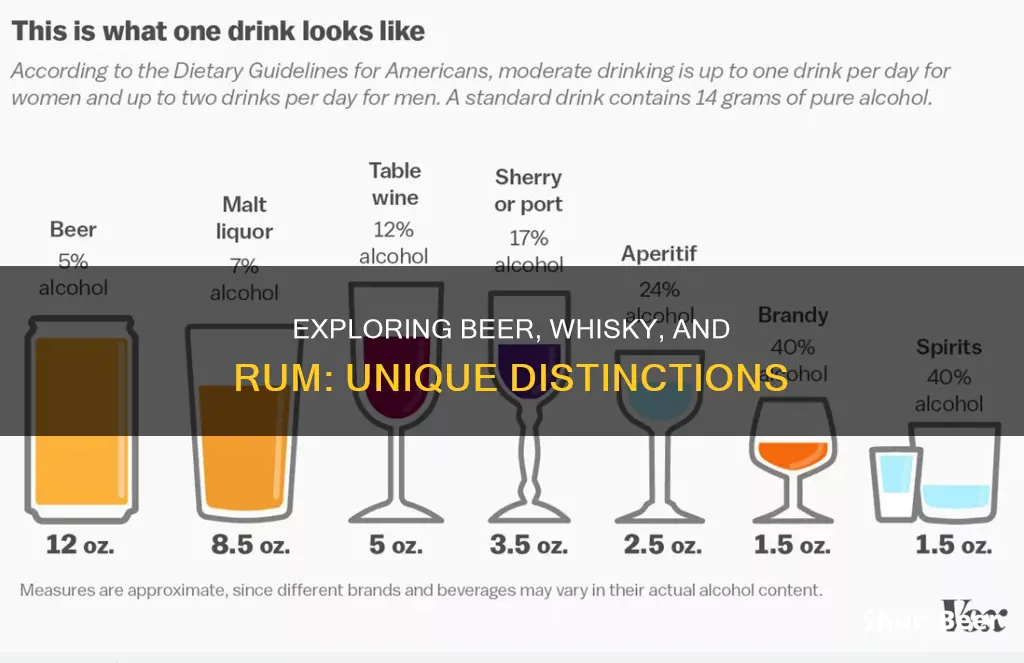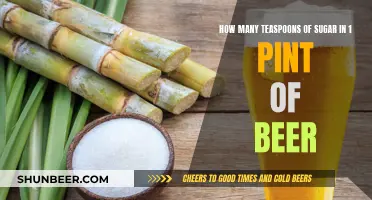
The main differences between beer, whisky, and rum lie in their ingredients, flavours, and the processes used to make them. Beer is made from fermented grains, usually barley, and contains hops to add a bitter taste. Whisky is distilled from grain mash, usually barley or corn, and is often aged in wooden barrels. Rum is made from sugarcane byproducts, such as molasses or sugarcane juice, and distilled in a similar way to whisky. Beer and wine are not distilled, whereas rum and whisky are, which is why they have a higher alcohol content.
Differences between Beer, Whisky, and Rum
| Characteristics | Values |
|---|---|
| Main Ingredient | Beer: fermented grains with hops; Whisky: fermented grain mash; Rum: sugarcane byproducts |
| Alcohol Content | Beer: 5-10%; Whisky: 40-60%; Rum: 40% (can be as high as 60%) |
| Colour | Beer: varies; Whisky: amber or brown; Rum: clear, dark, or gold |
| Flavour | Beer: bitter; Whisky: smokey or peaty; Rum: sweet with a spicy kick |
| Aging | Beer: not aged; Whisky: aged in wooden barrels; Rum: aged in wooden casks or stainless steel tanks |
| Origin | Beer: N/A; Whisky: Irish monasteries; Rum: Caribbean |
What You'll Learn
- Whisky is made from grains, while rum is made from sugarcane byproducts
- Whisky is aged in wooden barrels, while not all rum is aged
- Whisky is typically amber or brown, while rum can be clear or dark
- Whisky usually has a smokey or peaty flavour, while rum is usually sweet
- Whisky rarely contains added flavourings, but rum can be infused with spices or other flavours

Whisky is made from grains, while rum is made from sugarcane byproducts
Whisky and rum are both spirits, which are alcoholic beverages made through the process of distillation. However, they differ in their main ingredients and production methods.
Whisky is made from grains, such as barley, rye, wheat, and corn. The process of making whisky can be broken down into five stages: grain, beer, spirit, cask, and bottle. The grains are mashed, fermented, distilled, and then aged in wooden casks to create whisky. The type of grain and the specific production methods used can vary depending on the type of whisky being made, resulting in the wide array of whiskies available globally.
On the other hand, rum is made from sugarcane byproducts, primarily sugarcane juice or molasses. The sugarcane is harvested, and the juice is extracted by crushing or pressing the cane. The juice is then fermented by adding yeast and water, which converts the sugars into alcohol. The fermented liquid is then distilled and may be aged in wooden barrels, resulting in dark rum. Alternatively, it can be bottled immediately after distillation, creating clear rum. Spices and caramel may be added to adjust the colour and flavour of the rum.
In summary, the key difference between whisky and rum lies in their main ingredients and production methods. Whisky is made from grains and typically undergoes a more complex process involving distillation and ageing in wooden casks. Rum, on the other hand, is made from sugarcane byproducts and may or may not be aged, resulting in either dark or clear rum.
What Makes Beer Gas Tanks Unique?
You may want to see also

Whisky is aged in wooden barrels, while not all rum is aged
Whisky and rum are two of the most popular alcoholic drinks, but there are some key differences between them. One of the most significant differences is that whisky is always aged in wooden barrels, while not all rum varieties are aged.
Whisky is typically aged in oak barrels, which can be made from European, American, or Japanese oak trees. The ageing process can last for years, during which the whisky interacts with the wood, absorbing its unique flavours and characteristics. The oak imparts flavours such as vanilla, coconut, and spice to the whisky, and also helps to mellow out the spirit and reduce its alcohol content. The choice of oak species, the level of charring on the barrel, and the size of the barrel all contribute to the final flavour profile of the whisky.
On the other hand, rum is produced using a variety of methods and ingredients, resulting in different colours and flavours. While some rums are aged in wooden barrels, clear rum is often bottled immediately after distillation. Dark rums can also be unaged, achieving their colour through the addition of caramel and spices.
Aged rums are typically rested in oak barrels, similar to whisky, although the ageing process for rum is usually shorter. The oak barrels impart flavours such as vanilla, spice, and sweetness to the rum, rounding out its flavour and making it smoother. The type of oak used, as well as the previous contents of the barrel, can significantly impact the final flavour of the rum.
The decision to age whisky or rum is influenced by several factors, including the desired flavour profile, colour, and production techniques. By ageing whisky in wooden barrels, distillers can create a complex spirit with a distinctive colour and flavour. Rum producers, on the other hand, have more flexibility and can choose to age their product or bottle it immediately, resulting in a variety of rum styles.
Cask Ale and Beer: What's the Difference?
You may want to see also

Whisky is typically amber or brown, while rum can be clear or dark
Whisky and rum are two very distinct alcoholic drinks with different production processes, flavours, and colours. Whisky is typically amber or brown in colour, while rum can be clear or dark.
Whisky gets its colour from ageing in wooden barrels, which also gives it its distinctive flavour. The longer a whisky is aged, the darker it will be. Whisky is typically aged in oak barrels, and new barrels will give the whisky a darker colour. The colour of whisky comes from the extraction of polyphenols from the barrel during ageing.
On the other hand, rum can be clear or dark depending on various factors. Clear rum is not aged and can be bottled right after distillation. Dark rum gets its colour from ageing in wooden barrels, similar to whisky. The length of time that rum is aged also affects its colour, with light rums typically aged for around a year and dark rums aged for up to three years or more.
The colour of rum can also be influenced by the addition of colours, caramel, and spices. Dark rum may be black, red, or brown due to ageing and the addition of colours and spices.
In summary, whisky and rum have different colour profiles, with whisky typically being amber or brown, and rum ranging from clear to dark. These colours are influenced by factors such as ageing, barrel type, and the addition of colours and spices.
Stroh's Beer: Unique Characteristics and Distinctions
You may want to see also

Whisky usually has a smokey or peaty flavour, while rum is usually sweet
Whisky and rum are two very different drinks, each with its own distinct flavour profile. While whisky usually has a smokey or peaty flavour, rum is typically sweet. This difference arises primarily from the ingredients used and the production processes.
Whisky is made from fermented grain mash, typically barley, rye, wheat, or corn. The grain is milled and mixed with hot water to create a porridge-type mixture for fermentation. This process effectively releases the sugary starches in the cereal grains, allowing the yeast to convert them into alcohol. Whisky is then distilled, with most whiskies undergoing a double or triple distillation process.
The flavour of whisky is largely determined by the distillation and ageing processes. The distillation method, particularly the type of still used, can impart fruity or other notes to the whisky. However, the most significant contributor to whisky flavour is wood barrel ageing. The wood imparts bulk flavours and filters out undesirable compounds, resulting in the characteristic smokey or peaty taste of whisky. The length of ageing also affects the flavour, with longer ageing generally leading to a stronger flavour.
On the other hand, rum is made from sugarcane juice or molasses, which are distilled and fermented with yeast. The addition of spices like vanilla, cinnamon, and nutmeg gives rum its distinct flavour. Like whisky, rum can be aged in wooden barrels, typically oak, which imparts a smooth and mellow flavour. The length of ageing also affects the flavour of rum, with light rums typically aged for around a year and dark rums aged for up to three years or more.
While whisky and rum have some similarities, such as being distilled spirits, their flavour profiles differ significantly. Whisky's smokey or peaty flavour comes from the distillation and ageing processes, particularly the use of wooden barrels. In contrast, rum's sweet flavour is derived from its base ingredients of sugarcane and added spices.
Salt Life Beverage LLC: Exploring Their Beer Variety
You may want to see also

Whisky rarely contains added flavourings, but rum can be infused with spices or other flavours
Whisky and rum are two of the most popular alcoholic drinks globally, but they differ in many ways. While whisky is made from cereal grains, including corn, wheat, rye, and barley, rum is made from sugarcane juice or molasses. The fermentation process also varies between the two drinks. For whisky, the grains are milled and mixed with hot water to create a porridge-like mixture, whereas, for rum, the sugarcane is crushed to extract the juice, which is then mixed with yeast.
Whisky and rum also differ in their appearance, with rum being clear or dark, and whisky typically having an amber or brown colour. In terms of flavour, rum is usually sweet, whereas whisky tends to be smoky or peaty.
One of the most significant differences between whisky and rum is the addition of spices and flavourings. Whisky rarely contains added flavourings, as many types of whisky are prohibited from adding flavours. The flavour of whisky is primarily derived from the distillation and ageing processes, with the wood barrels imparting a range of flavours such as caramel and vanilla.
On the other hand, rum can be infused with spices and other flavourings, resulting in spiced rum. Spiced rum typically includes additives like caramel, orange peel, brown sugar, vanilla, molasses, and spices, giving it a sweeter and more robust taste. The spices used in spiced rum can include cinnamon, allspice, nutmeg, ginger, and pepper. The process of infusing rum with spices is relatively simple, requiring only a few days for the flavours to infuse into the rum.
Exploring the Diverse Flavors of Beer: A Tasty Adventure
You may want to see also
Frequently asked questions
Beer is fermented grains. Beer is not distilled like liquor. It is carbonated because the yeast used to produce alcohol also makes carbon dioxide.
Whisky is a distilled beverage made from fermented grain mash, including barley, rye, wheat, and corn. Whisky is typically aged in wooden barrels, which give it its distinctive colour and flavour.
Rum is a distilled spirit made from sugarcane juice or molasses. Rum is typically drunk neat or on the rocks, but it can also be used in cocktails.
The main difference is in the ingredients and how they are made. Beer is made from fermented grains, whisky is distilled from fermented grain mash, and rum is distilled from sugarcane juice or molasses.







